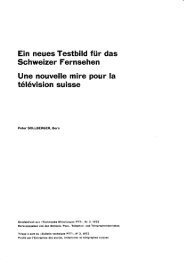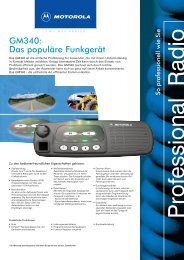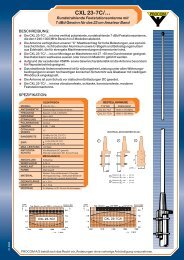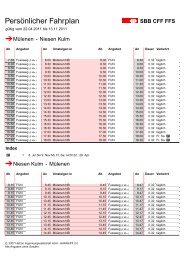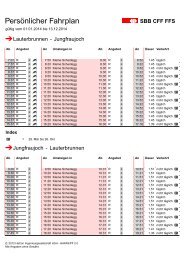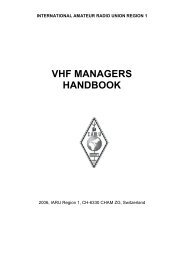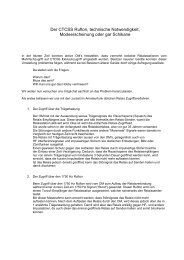IARU REGION 1 VHF/UHF/Microwaves BANDPLANS
IARU REGION 1 VHF/UHF/Microwaves BANDPLANS
IARU REGION 1 VHF/UHF/Microwaves BANDPLANS
- No tags were found...
You also want an ePaper? Increase the reach of your titles
YUMPU automatically turns print PDFs into web optimized ePapers that Google loves.
IIc144 - 146 MHz BANDPLAN ( San Marino 2002)Frequency(MH )144.000144.035144.035144 135144.135144.150144.150MaximumB d idthMODEUSAGE500Hz Telegraphy (a) EME exclusive500Hz500Hz2700HzTelegraphy(a)144.050 Telegraphy calling144.100 Random MS(m)Telegraphy, MGM 144.138 PSK31 center ofactivity144.140-144.150 FAI & EMEactivitytelegraphy144.150-144.160 FAI & EMETelegraphy, SSB, MGMactivity SSB144.165144.165144.360144.3602700Hz2700Hz144.195-144.205 Random MS SSB (m)Telegraphy & SSB144.300 SSB calling144.370 FSK441 RandomTelegraphy, SSB, MGMcalling(m)144.399144.400144.490144.500144.794144.794144.990144.994145.194145194145.206145.206145.5935500Hz Telegraphy, MGM Beacons exclusive(b)20kHzAll mode (f)144.500 SSTV calling144.525 ATV SSBtalk back144.600 RTTY calling(n)144.630-144.660 LinearTransponderOUT144.660-144.690 LinearTransponder IN144.700 FAX calling144.750 ATV talk back12kHz MGM (h) 144.800 APRS12kHz FM Repeater Input exclusive (c)12kHz FM Space communication (p)145.300 RTTY local12kHzFM145.500 (mobile) callingIIc -page 6 nov02
IIc145.594145.7935145.794145.806145.806146.00012kHz FM Repeater Output exclusive (c,d)12kHz FM Space communication (p)12kHz ALL MODE (e) Satellite exclusiveNOTES ON THE 144 - 146 MHz BANDPLAN1. <strong>IARU</strong> <strong>REGION</strong> 1 BANDPLANThe following notes are part of the officially adopted <strong>IARU</strong> Region 1 bandplan, and all member societiesshould strongly promote adherence to the recommendations made in these notes.1.1. Generali. In Europe no input or output channels of telephony repeaters shall be allowed to operatebetween 144.000 and 144.794 MHz.ii. Except in the part of the band allocated to the Amateur Satellite Service and the lineartransponders it is not allowed to use input- or output frequencies in the 145 MHz band forrepeaters with in- or output in other amateur bands (Miskolc-Tapolca 1978, San Marino2002).iii. No packet-radio networks will be set up in the 145 MHz band (revised Lillehammer 1999)It is recognised that in some parts of Region 1 the introduction of packet-radiomay require the use of access frequencies in the 144 - 146 MHz band for alimited time (Düsseldorf 1989).Note.The parts of Region 1 meant are those parts with low amateur population and/orthose at the periphery of the Region, where exceptions can be tolerated as thesedo not harm the orderly use of the band in the parts of Region 1 where there is agreater pressure on the available spectrum space. In the latter part of the Regionthe second paragraph of the footnote should never be used to justify ignoring thefirst part for a considerable time.iv.Beacons, irrespective of their ERP, will have to be situated in the beacon part of the band.1.2. Footnotesa. Telegraphy is permitted over the whole band, but preferably not in the beacon band;Telegraphy exclusive between 144.000 - 144.135 MHz.b. Within <strong>IARU</strong> Region 1 the frequencies for beacons with an ERP of more than 50 Wattsare coordinated by the <strong>IARU</strong> Region 1 Beacon Coordinator; the frequencies for beaconswith and ERP of 10 Watts or more shall be communicated to the Beacon Coordinator.(see section IX).c. For technical standards on NBFM and repeaters see section VIbIIc -page 7 nov02
IIcIf there is a real need for more repeater channels (see section VIIIa ! ), it is recommendedthat Societies or Repeater Groups consider setting up a repeater system on the higherfrequency band(s).Further to this subject the following recommendation was adopted in De Haan, 1993:For FM repeater and simplex operation in the 144 to 146 MHz band <strong>IARU</strong> Region1 will change to a genuine 12.5 kHz channel spacing system.Furthermore in Tel Aviv, 1996 it was decided that societies shall promote the useof the 12.5 kHz channel spacing standard for NBFM channels in order toeffectively implement the 12.5 kHz system .For the numbering of NBFM telephony channels, see annex 2 to this section.d. Established simplex frequencies on repeater output channels may be retained.e. In view of the important public relations aspect of amateur satellite activities, it wasdecided at the <strong>IARU</strong> Region 1 Conference in Miskolc-Tapolca (1978) that:i) AMSAT will be allowed to use the band 145.8 - 146.0 MHz for amateur satelliteactivity.This decision was re-confirmed at the <strong>IARU</strong> Region 1 Conference in Brighton(1981).iii)see also footnote p2. USAGEf. No unmanned stations shall use the all-mode segment, except for linear transponders(Tel Aviv 1996, San Marino 2002)g. Attention is drawn to section 1.1. point iii of these Bandplan notes!h. Network stations shall only operate in the part of the 145 MHz band allocated to DigitalCommunications and will be permitted only for a limited time. Such network stationsshould also have access ports on other <strong>VHF</strong>/<strong>UHF</strong> or Microwave bands and should notuse the 145 MHz band to forward traffic to other network stations. In view of the timelimitation the set-up of new network stations is not encouraged (De Haan, 1993).Unmanned packet radio stations are only allowed in the segment 144.800 - 144.990 MHz.Outside of this segment the signal level produced by those stations shall be not largerthan 60 dB below the carrier level (measured in a 12 kHz bandwidth). Any otherunmanned packet radio and digital access points must cease operation not later than 31December 1997.(Tel Aviv 1996).The following notes are referring to the Usage column in the bandplan. As already set out in theintroduction to section IIc, in the right amateur spirit operators should take notice of theseagreements which are made for operating convenience, but no right to reserved frequencies canbe derived from a mention in the Usage column or from the following notes.At the meeting of the <strong>VHF</strong>/<strong>UHF</strong>/<strong>Microwaves</strong> Committee in Vienna, March 1992, the followingrecommendation was adopted:Societies should publish the use of 144.140 - 144.160 MHz as an alternative for EMEoperation. The results of this test should be monitored with the aim of incorporating thissegment as EME alternative into the Usage part of the bandplan if successful.IIc -page 8 nov02
IIc2.1. Footnotesm. See procedures set out in section Vb.n. Publicity should be given to the usage of frequencies around 144.600 MHz by RTTYstations , in order to keep these frequencies clear from other traffic and to avoidinterference with those RTTY stations.p. For NBFM voice communications with special stations like manned spacecraft it isrecommended to use 145.200 MHz for simplex operation or 145.200/145.800 MHz forsplit-channel operation (Vienna 1995/Tel Aviv 1996).IIc -page 9 nov02




